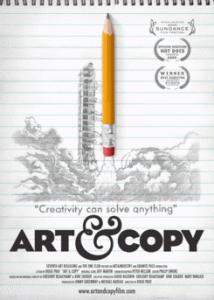
Many SMB clients are savvy marketers, yet they're caught by surprise when advised that they need a professional ad copywriter on their graphic design project.
Virtually all my graphic designer partners hear it. A new client turns to them for their design expertise for a print ad, direct mail, web, broadcast, or brochure project only to be advised that to make their project work they need professionally written copy, too. Often the reaction from small and medium-sized business clients is that they can write copy on their own; maybe even tap a relative or employee. “Hey, I got good grades in English. How hard could it be?”
If they expect results, harder than they think.
Savvy designers recognize this common misconception and urge their clients to hire a professional advertising copywriter.
If you’re a graphic designer who needs to convince clients to take a copywriter on board, on behalf of myself and my colleagues, here are some benefits to emphasize.
First off, there’s a world of difference between advertising copywriters and other writers like journalists, P.R. writers, business writers, content writers, etc.
They do their thing, we do ours.
Our thing is based on an instinctive understanding that nobody buys advertising and marketing communications as they would other media. Advertising is not an event, it’s an interruption.
The copywriter’s mantra is, “I must make them care.” And then convince them to act.
This process of instant engagement has just seconds to take hold – or else that potential customer is gone, perhaps forever. Creating instant engagement isn’t learned from a book. It’s a skill acquired from years of operating deep inside the media jungle where the average American is bombarded by more than 4,000 advertising messages every day.
Teamed with the designer/art director, the copy pro must create a concept that seizes the audience’s attention in a relevant way and never lets go until the call-to-action is driven home. This requires writing finesse, marketing smarts, entertainment chops, and even an understanding of the visual side of advertising creative development. In fact, sometimes the copywriter will come up with the idea for the visual while the designer/art director conjures up a headline.
We’re shape shifters. We crawl into and under the customer’s skin to understand their needs and desires through their eyes. “A copywriter should have an understanding of people, an insight into them, a sympathy toward them,” said George Gribbin, former CEO of mega ad agency Young & Rubicam.
We’re detectives, too. We poke and probe to unearth the hidden assets of clients’ products and services. We then apply showmanship to present them in the most entertaining– and ultimately convincing – light to potential customers.
A copywriter knows how to work with all members of the creative and marketing team. We have a keen appreciation and understanding of the designer/art director’s critical role in the advertising creation process. The best of us go beyond words to become creative consultants who can tackle marketing strategy, messaging, branding, look-and-feel, identifying unique selling propositions and maybe even provide a media recommendation or two. As freelancers, we sometimes even take on the functions of account planners at ad agencies.
Copy pros have the experience to apply original language and ideas that seize attention, as opposed to concepts and copy that are immediately ignored because they’re trite. To quote the legendary copywriter Bill Bernbach, “be sure your advertising is saying something with substance, something that will inform and serve the consumer. And be sure you’re saying it like it’s never been said before.”
We also know that peoples’ time and the space we have to advertise to them is precious. There’s neither time nor room for wasted words, inflated claims, and muddled messages. Great copy leaps to the point, pronto. “Advertising says to people, ‘here’s what we’ve got. Here’s what it will do for you. Here’s how to get it,” said Leo Burnett, founder of his famous eponymous Chicago ad agency.
To borrow the more than eighty-year-old tag line of another agency, McCann Erikson, effective ad copy is “truth well told.” And, to tell the truth, it takes a pro to do the telling.
So, there you have it – powerful ammo to use the next time a new client says, “we need a copy what? Why?”
For more about me and my services, visit www.bobdevol.com.









 Imagine advertising created without copywriters and art directors. Ads, commercials, designs, logos, even whole campaigns conjured up by hundreds of erstwhile “creatives” out there…somewhere…somehow…
Imagine advertising created without copywriters and art directors. Ads, commercials, designs, logos, even whole campaigns conjured up by hundreds of erstwhile “creatives” out there…somewhere…somehow…
 Have you ever wished you could prove the importance of breakthrough creative to your clients? Here’s a suggestion: make sure they see “Art & Copy,” a new documentary film directed by Doug Pray and sponsored by The One Club.
Have you ever wished you could prove the importance of breakthrough creative to your clients? Here’s a suggestion: make sure they see “Art & Copy,” a new documentary film directed by Doug Pray and sponsored by The One Club. In the most recent issue of Communication Arts, Robert Greenburg of R/GA boldly states that the “Bernbach Model” of copywriter/art director teams as the genesis of advertising creative is dead.
In the most recent issue of Communication Arts, Robert Greenburg of R/GA boldly states that the “Bernbach Model” of copywriter/art director teams as the genesis of advertising creative is dead.